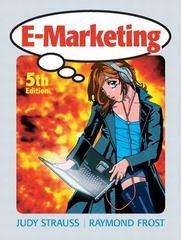Question
There is an industry controlled by a monopolist that is not regulated so the Monopolist will maximize profits with no interference.Recall the Marginal Revenue of
There is an industry controlled by a monopolist that is not regulated so the Monopolist will maximize profits with no interference.Recall the Marginal Revenue of any firm with "market power" is the change in total revenue as quantity changes, which could lead to the "arc approach" of calculating MR.Also recall the marginal revenue is the slope of the total revenue curve as quantity of output changes, which leads to the "point slope approach".For mathematical reasons, when trying to determine the optimal quantity to maximize profits, the slope approach is easiest to use.In notation from lecture notes #8 the slope approach can be written:MR = TR / Q =P + Q P / Q with P / Q being the slope of the demand curve.If the demand curve is estimated by a simple linear function of the form QD= a + b P with b < 0, then recall the slope of the demand curve is 1 / b.Substituting,MR =P + Q / b.To get the MR to a function of only Q, the P needs to be eliminated.Convert the demand curve into an "inverted demand curve" to get P = [Q - a] / b then substitute the right side into the MR equation to getMR = [[Q - a] / b] + [Q / b].Rearrange and simplify to get MR = [2Q/b] - [a/b].After analyzing industry daily demand and conducting some experiments, "a" is estimated to equal 49 and b equals -1.4.
The monopolist estimates its daily marginal cost function to be MC = x + y Q with x = 2.4 and y = 0.9.How many units should the monopolist produce to maximize its profits or producer's surplus?Note that once you have the optimal Q, it can be proven by plugging the Q into both the MR and MC curves.Please round to 2 decimals, for example 37.15 or 52.82.
Quantity:
53.What price would the monopolist charge consumers for each unit it produces?Please round to one cent, for example$12.36 or $41.55.
Price:
54.At the monopolist's optimal quantity and price, how much revenue is it collecting?Please round to one cent, for example $459.17 or $194.53.
Spending and Revenue:
55.At the monopolist's optimal quantity and price, what is the "producer's surplus"?Please round to one cent, for example $29.32 or $71.31.There are several approaches to estimate the producer's surplus.One is to estimate the area.The second is to estimate "Total Costs" and then deduct it from revenue.Another is to calculate Average Cost per unit and then deduct it from price to get profit per unit and then multiply by the optimal Q.All 3 methods should give the same result.
Producer's Surplus:
56.At the monopolist's optimal quantity and price, what is the "consumer's surplus"?Please round to one cent, for example $8.55 or $17.73.
Consumers' Surplus:
II.Short Answer Questions and related True or False:
57.A past article in the Wall Street Journal described the situation surrounding the closure of a chicken processing plant by Pilgrim's Pride, a chicken processor that was operating under bankruptcy protection at the time the article was written.There was a controversy over whether Pilgrim's Pride was making a serious effort to find a buyer for the plant in Georgia.The company claimed it was while local farmers and workers claim it was not.As evidence of the lack of good faith, locals cited Pilgrim's dismantling of chicken operations in the area, slaughtering hens and selling off eggs.Pilgrim claimed the steps were necessary because "you can't close a plant and have tens of thousands of live chickens there with no place to go."Townspeople viewed the actions as a sign Pilgrim's wasn't serious about selling the plant, as it can take up to two years to restart operations once chicken production is interrupted.In economic terms, for this plant two years is the "long term".Is the statement true [enter a T on the spreadsheet], or false [enter an F on the spreadsheet], or Indeterminate [enter an "I" on the spreadsheet]?Briefly explain your answer.
58.The processing plant was not operating at the time the article was written and the sheds where the chickens are raised were not in use.The article reads: "A group of Douglas chicken farmers gathered outside an empty chicken house in Douglas, Ga.With no plant to process the birds they raise, local chicken farmers have no income to pay off debts.Months ago, the hundreds of cavernous, metal-and-wood chicken houses in the county were worth at least $200,000 each when filled with chickens, farmers say.Now, except for flies and old feathers, the structures sit empty."It can be concluded from the quotes that the chicken facilities in the town have "exited" the industry.Is the statement true [enter a T on the spreadsheet], or false [enter an F on the spreadsheet], or Indeterminate [enter an "I" on the spreadsheet]?Briefly explain your answer.
59.An excerpt from the article reads: "In 2007, the chicken business was booming. But chicken prices fell about 35% by the end of 2008 from the highs of 2007; poultry producers faced rising prices for feed and slackening exports."The higher feed prices would have shifted the chicken producers' marginal cost curve up or to the left.]
TrueFalse[no explanation needed]
60.From the excerpt quoted in question 55, it can be concluded that chicken prices fell in 2008 due to the changing marginal cost curve.
TrueFalse[no explanation needed]
Step by Step Solution
There are 3 Steps involved in it
Step: 1

Get Instant Access to Expert-Tailored Solutions
See step-by-step solutions with expert insights and AI powered tools for academic success
Step: 2

Step: 3

Ace Your Homework with AI
Get the answers you need in no time with our AI-driven, step-by-step assistance
Get Started


